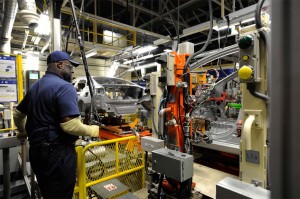
Hyundai's plant in Montgomery, Alabama, may be getting another production line to meet demand for crossovers in the U.S.
Hyundai has a problem…a good problem: it can’t build enough vehicles to meet demand. As a result, it is looking to expand its production capability in the U.S. to meet the demand for its crossovers and SUVs.
The South Korean automaker has seen its marketshare in the U.S. slide as sales of crossovers and SUVs has risen in the last several months in concert with a steady decline in gas prices. The automaker’s strategy in the U.S. has focused on building more cars at its two facilities here.
However, it’s now scrambling to decide whether it should add another production line at its plant in Montgomery, Alabama, where it currently builds the Sonata and Elantra. The new line, which Hyundai is not confirming, could take on production of its Santa Fe crossover, which is currently produced in Georgia, or the smaller Tucson, which is imported from Korea.
A new production line may not be enough for future demand. According to Yonhap News Agency, the company is considering adding a new plant that could build as many as 300,000 Tucsons and Sante Fes by 2017.
Dave Zuchowski, CEO of Hyundai North America, told TheDetroitBureau.com in several interviews in recent months that the automaker needs to expand its production capabilities. The maker’s sister company, Kia, recently built an additional plant in Mexico to meet North American demand.
(Hyundai pulls wraps off 2016 Tucson. For more, Click Here.)
Hyundai’s Alabama plant is capable of producing crossovers, but it’s running full out right now, producing 400,000 cars a year.
(Click Here to see the upgrades to the Hyundai Veloster and Elantra for 2016.)
Actually, Hyundai doesn’t even produce the Santa Fe Sport crossover in the U.S.: it is built at the Kia plant in West Point, Georgia, that also makes the Kia Sorento crossover and the Kia Optima sedan. It’s also maxed out producing 300,000 units annually.
(To see more about Honda’s national ad campaign urging airbag replacements, Click Here.)
Since the companies are already sharing a plant in Georgia, it’s certainly possible that a new Hyundai plant could be located near the $1 billion Kia plant in Nuevo Leon. The facility should be complete in the first half of 2016 and be able to produce 300,000 vehicles a year; however, Zuchowski has been mum on the subject of where a new plant would be built, if it were happen at all.
Part of the reason the company hasn’t grappled with this problem sooner is that Hyundai’s senior leadership restricted production increases to allow the maker’s supplier base to catch up with the company’s growth while improving quality. However, the cap is off now and the need and speculation is on.
